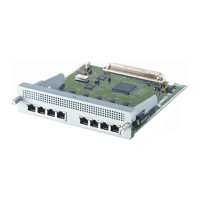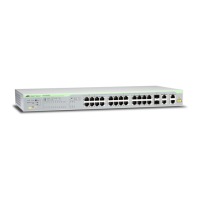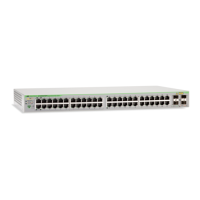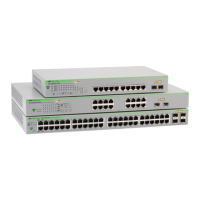Configuring an SNMP Community Introduction
7-53
Software Reference for SwitchBlade x3100 Series Switches (Network Management)
7.3.4 Default Configuration
The initial status of an SNMP configuration is as follows (see the switch output for detail):
• The Status is DISABLED
• The Authentication Failure Traps are DISABLED.
• The SNMP counters are all set to 0.
officer SEC> SHOW SNMP
----------------------------------------------------------------------
SNMP Configuration:
-----------------------------
Status....................... DISABLED
Authentication Failure Traps. DISABLED
SNMP Counters:
----------------------------
inPkts...................... 0 outPkts...................... 0
inBadVersions............... 0 outTooBigs................... 0
inBadCommunityNames......... 0 outNoSuchNames............... 0
inBadCommunityUses.......... 0 outBadValues................. 0
inASNParseErrs.............. 0 outGenErrs................... 0
inTooBigs................... 0 outGetRequests............... 0
inNoSuchNames............... 0 outGetNexts.................. 0
inBadValues................. 0 outSetRequests............... 0
inReadOnlys................. 0 outGetResponses.............. 0
inGenErrs................... 0 outTraps..................... 0
inTotalReqVars.............. 0
inTotalSetVars.............. 0
inGetRequests............... 0
inGetNexts.................. 0
inSetRequests............... 0
inGetResponses.............. 0
inTraps..................... 0
7.3.5 Restrictions and Limitations
•
SNMP commands can only be input by a Security Officer.
• Up to 12 SNMP communities can be configured on one system.
• The SNMP set message is not supported in release 14.2.
• SNMP version 3 is not supported.
7.3.6 Configuration Procedure
The main steps for configuring an SNMP community are as follows:
• Use the SHOW SNMP command to see the initial SNMP configuration. (For example output, see 7.3.4,
Default Configuration.)
• Enable SNMP so it is possible to create an SNMP community.
• Enable SNMP authentication traps.
• Create the SNMP community; provide a name and the list of trusted trap hosts and management stations.
• Enable the SNMP community, and then enable traps for that community.
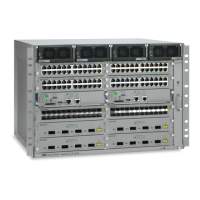
